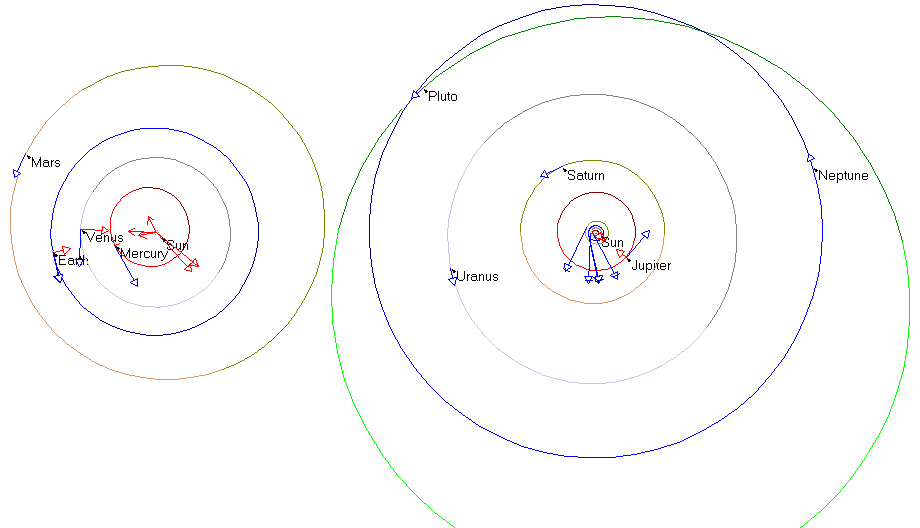for use with the Force and velocity simulation
from the materialworlds Solar System simulations
© materialworlds.com 2002

The Force and velocity simulation shows forces and velocities in the ecliptic plane - the plane in which the Earth orbits. As most planets orbit roughly in the ecliptic, this view gives a reasonable representation of their motion and the forces on them.
Gravitational forces between the bodies in the Solar System are shown with red arrows, and their velocities with blue arrows.
Beyond a certain length - indicated by a bar across the arrow - the arrows grow logarithmically (so that a doubling in force or velocity would be shown as a fixed increase in length). This allows a much greater range of magnitudes of force and velocity to be displayed side-by-side on the screen. Make sure you remember that an arrow with a bar half way along its length represents a force or velocity much greater than double an arrow half its length.
Increase the "Arrow scaling" and "Zoom" controls to view weaker forces
1. List, in order of decreasing strength, the main gravitational forces on the Sun.
You can identify which planet is doing the attracting for each force arrow, not only from the direction in which it points, but also from the rate at which is rotates (like a hand on a clock face).
2. There is one source of gravitational attraction that you might find it difficult to place in the list.
What is it and why is it difficult to place?
3.
a) What is the relationship (in strength and direction) between the Sun's attraction to a particular planet, and that planet's attraction to the Sun? (both being represented as force arrows)
b) Why, then, do we only think of the planets moving, not the Sun?
4. List, in order of decreasing strength, the main gravitational forces on the Earth.
You'll need to zoom right into the Earth view for this. Red force arrows for four different sources of gravitational attraction - one of them transitory - should be visible. Each force arrow points at the source of gravitational attraction.
5.
a) What is the greatest force on the Sun? Why?
b) In what direction is the resultant force on the Sun? Why?
Questions requiring further research...
6.
a) What information would you need to calculate the relative strength of different planets' gravitational pulls on the Sun?
b) Get this information and perform the calculation.
c) Do your answers result in the same list is question 1.?
Additional information - "nine planets" Solar system data:
http://www.seds.org/nineplanets/nineplanets/datamax.html